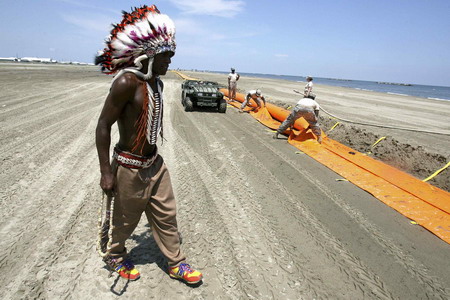Asia-Pacific
Relief for Gulf is 2 months away with another well
(Agencies)
Updated: 2010-06-01 10:17
 |
Large Medium Small |
|
|
NEW ORLEANS - The best hope for stopping the flow of oil from the blown-out well at the bottom of the Gulf of Mexico has been compared to hitting a target the size of a dinner plate with a drill more than two miles into the earth, and is anything but a sure bet on the first attempt.
Bid after bid has failed to stanch what has already become the nation's worst-ever spill, and BP PLC is readying another patchwork attempt as early as Wednesday, this one a cut-and-cap process to put a lid on the leaking wellhead so oil can be siphoned to the surface.
"The probability of them hitting it on the very first shot is virtually nil," said David Rensink, incoming president of the American Association of Petroleum Geologists, who spent most of his 39 years in the oil industry in offshore exploration. "If they get it on the first three or four shots they'd be very lucky."
For the relief well to succeed, the bore hole must precisely intersect the damaged well. If it misses, BP will have to back up its drill, plug the hole it just created, and try again.
The trial-and-error process could take weeks, but it will eventually work, scientists and BP said. Then engineers will then pump mud and cement through pipes to ultimately seal the well.
As the drilling reaches deeper into the earth, the process is slowed by building pressure and the increasing distance that well casings must travel before they can be set in place.
Still, the three months it could take to finish the relief wells -- the first of which started May 2 -- is quicker than a typical deep well, which can take four months or longer, said Tad Patzek, chair of the Petroleum and Geosystems Engineering Department at the University of Texas-Austin. BP already has a good picture of the different layers of sand and rock its drill bits will meet because of the work it did on the blown-out well.
On the slim chance the relief well doesn't work, scientists weren't sure exactly how much -- or how long -- the oil would flow. The gusher would continue until the well bore hole collapsed or pressure in the reservoir dropped to a point where oil was no longer pushed to the surface, Patzek said.
"I don't admit the possibility of it not working," he said.
A third well could be drilled if the first two fail.
"We don't know how much oil is down there, and hopefully we'll never know when the relief wells work," BP spokesman John Curry said.
The company was starting to collect and analyze data on how much oil might be in the reservoir when the rig exploded April 20, he said.
BP's uncertainty statement is reasonable, given they only had drilled one well, according to Doug Rader, an ocean scientist with the Environmental Defense Fund.
Two relief wells stopped the world's worst peacetime spill, from a Mexican rig called Ixtoc 1 that dumped 140 million gallons off the Yucatan Peninsula. That plug took nearly 10 months beginning in the summer of 1979. Drilling technology has vastly improved since then, however.




